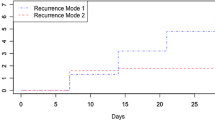Abstract
This paper discusses regression analysis of panel count data that often arise in longitudinal studies concerning occurrence rates of certain recurrent events. Panel count data mean that each study subject is observed only at discrete time points rather than under continuous observation. Furthermore, both observation and follow-up times can vary from subject to subject and may be correlated with the recurrent events. For inference, we propose some shared frailty models and estimating equations are developed for estimation of regression parameters. The proposed estimates are consistent and have asymptotically a normal distribution. The finite sample properties of the proposed estimates are investigated through simulation and an illustrative example from a cancer study is provided.
Similar content being viewed by others
References
Andrews DF, Herzberg AM (1985) Data: a collection of problems from many fields for the student and research worker. Springer-Verlag, New York
Byar DP (1980) The veterans administration study of chemoprophylaxis for recurrent stage I bladder tumors: comparisons of placebo, pyridoxine, and topical thiotepa. In: Pavane-Macaluso M, Smith PH, Edsmyr F (eds) Bladder tumors and other topics in urological oncology. Plenum, New York, , pp 363–370
Cheng SC, Wei LJ (2000) Inferences for a semiparametric model with panel data. Biometrika 87: 89–97
De Gruttola V, Tu X (1994) Modelling progression of CD4-lymphocyte count and its relationship to survival time. Biometrics 50: 1003–1014
Fan J, Li R (2002) Variable selection for Cox’s proportional hazards model and frailty model. Ann Stat 30: 74–99
He X, Tong X, Sun J, Cook R (2008) Regression analysis of multivariate panel count data. Biostatistics 9: 234–248
Huang X, Liu L (2007) A joint frailty model for survival time and gap times between recurrent events. Biometrics 63: 389–397
Huang CY, Wang MC (2004) Joint modeling and estimation for recurrent event processes and failure time data. J Am Stat Assoc 99: 1153–1165
Huang CY, Wang MC, Zhang Y (2006) Analysing panel count data with informative observation times. Biometrika 93: 763–775
Kalbfleisch JD, Lawless JF (1985) The analysis of panel data under a Markov assumption. J Am Stat Assoc 80: 863–871
Kalbfleisch JD, Prentice RL (2002) The statistical analysis of failure time data, 2nd edn. Wiley, New York
Lipsitz SR, Fitzmaurice GM, Ibrahim JG, Gelber R, Lipshultz S (2002) Parameter estimation in longitudinal studies with outcome-dependent follow-up. Biometrics 58: 621–630
Liu L, Huang X (2007) The use of Gaussian quadrature for estimation sin frailty proportional hazards models. Stat Med. doi:10.1002/sim.3077
Liu L, Huang X, O’Quigley J (2007) Analysis of longitudinal data in the presence of informative observational times and a dependent terminal event, with application to medical cost data. Biometrics. doi:10.1111/j.1541-0420.2007.00954.x
Liu L, Wolfe RA, Huang X (2004) Shared frailty models for recurrent events and a terminal event. Biometrics 60: 747–756
Louis TA (1982) Finding the observed information matrix when using the EM algorithm. J Roy Stat Soc Ser B 44: 226–233
Rondeau V, Mathoulin-Pelissier S, Jacqmin-Gadda H, Brouste V, Soubeyran P (2007) Joint frailty models for recurring events and death using maximum penalized likelihood estimation: application on cancer events. Biostatistics 8: 708–721
Roy J, Lin X (2002) Analysis of multivariate longitudinal outcomes with non-ignorable dropouts and missing covariates: changes in methadone treatment practices. J Am Stati Assoc 97: 40–52
Song X, Davidian M, Tsiatis AA (2002) A semiparametric likelihood approach to joint modeling of longitudinal and time-to-event data. Biometrics 58: 742–753
Sun J, Kalbfleisch JD (1995) Estimation of the mean function of point processes based on panel count data. Stat Sinica 5: 279–290
Sun J, Tong X, He X (2007) Regression analysis of panel count data with dependent observation times. Biometrics 63: 1053–1059
Sun J, Wei LJ (2000) Regression analysis of panel count data with covariate-dependent observation and censoring times. J Roy Stat Soc Ser B 62: 293–302
Thall PF, Lachin JM (1988) Analysis of recurrent events: Nonparametric methods for random-interval count data. J Am Stat Assoc 83: 339–347
Wang MC, Qin J, Chiang CT (2001) Analyzing recurrent event data with informative censoring. J Am Stat Assoc 96: 1057–1065
Wellner JA, Zhang Y (1998) Large sample theory for an estimator of the mean of a counting process with panel count data. Technical Report, Department of Statistics, University of Washington, Seattle
Wellner JA, Zhang Y (2000) Two estimators of the mean of a counting process with panel count data. Ann Stat 28: 779–814
Wulfsohn MS, Tsiatis AA (1997) A joint model for survival and longitudinal data measured with error. Biometrics 53: 330–339
Ye Y, Kalbfleisch JD, Schaubel DE (2007) Semiparametric analysis of correlated recurrent and terminal events. Biometrics 63: 78–87
Zhang Y (2002) A semiparametric pseudolikelihood estimation method for panel count data. Biometrika 89: 39–48
Author information
Authors and Affiliations
Corresponding author
Rights and permissions
About this article
Cite this article
He, X., Tong, X. & Sun, J. Semiparametric analysis of panel count data with correlated observation and follow-up times. Lifetime Data Anal 15, 177–196 (2009). https://doi.org/10.1007/s10985-008-9105-1
Received:
Accepted:
Published:
Issue Date:
DOI: https://doi.org/10.1007/s10985-008-9105-1



